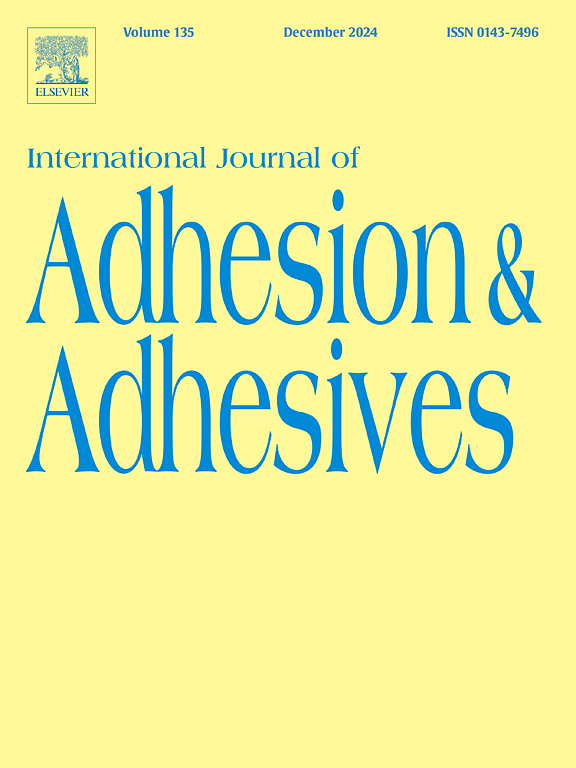Effect of the adhesion process and fiber orientation for low-velocity impact response of AA6061-T6 bonded with GFRP
IF 3.5
3区 材料科学
Q2 ENGINEERING, CHEMICAL
International Journal of Adhesion and Adhesives
Pub Date : 2025-07-12
DOI:10.1016/j.ijadhadh.2025.104103
引用次数: 0
Abstract
Dissimilar material joints, such as composite materials combined with lightweight metals, have been widely used in the automobile and aerospace industries to improve fuel efficiency and reduce weight. Therefore, accurate analysis and study of the mechanical behavior of dissimilar material joints are fundamentally required. In this study, impact test analysis was performed on one-sided fiber glass composite bonded with aluminum to investigate the effect of the adhesion process and directional fiber orientation on the low-velocity impact response. Two different adhesion processes (secondary cure and co-cure) were evaluated, along with four fiber orientations (0/90°, ±15°, ±30°, and ±45°). The results demonstrated that ±30° fiber orientation exhibited the highest energy absorption, confirming its superior impact resistance. For lower fiber angles (0/90° and ±15°), secondary cure and co-cure performed similarly, with co-cure bonding showing slightly lower energy absorption. However, at higher fiber angles (±30° and ±45°), co-cure bonding significantly improved fracture resistance by reducing the fiber pullout and promoting interfacial-dominated failure modes (brooming and fiber crushing). A detailed fractographic and digital image analysis identified the different fracture zones: crack initiation, shear lips, crack propagation, final fracture, and their relations with the adhesion process and fiber orientation.

粘接工艺和纤维取向对GFRP粘结AA6061-T6低速冲击响应的影响
异种材料接头,如复合材料与轻质金属结合,已广泛应用于汽车和航空航天工业,以提高燃油效率和减轻重量。因此,对异种材料接头的力学行为进行准确的分析和研究是十分必要的。本研究对单面玻璃纤维复合材料与铝的粘结进行了冲击试验分析,研究了粘结工艺和纤维定向取向对低速冲击响应的影响。评估了两种不同的粘附过程(二次固化和共固化),以及四种纤维取向(0/90°,±15°,±30°和±45°)。结果表明,纤维取向为±30°时吸能最高,具有较好的抗冲击性能。对于较低的纤维角度(0/90°和±15°),二次固化和共固化的表现相似,共固化键合的能量吸收略低。然而,在更高的纤维角度(±30°和±45°)下,共固化粘合通过减少纤维拉出和促进界面主导的破坏模式(刷毛和纤维破碎),显著提高了抗断裂能力。通过详细的断口分析和数字图像分析,确定了不同的断裂区域:裂纹萌生、剪切唇、裂纹扩展、最终断裂,以及它们与粘附过程和纤维取向的关系。
本文章由计算机程序翻译,如有差异,请以英文原文为准。
求助全文
约1分钟内获得全文
求助全文
来源期刊

International Journal of Adhesion and Adhesives
工程技术-材料科学:综合
CiteScore
6.90
自引率
8.80%
发文量
200
审稿时长
8.3 months
期刊介绍:
The International Journal of Adhesion and Adhesives draws together the many aspects of the science and technology of adhesive materials, from fundamental research and development work to industrial applications. Subject areas covered include: interfacial interactions, surface chemistry, methods of testing, accumulation of test data on physical and mechanical properties, environmental effects, new adhesive materials, sealants, design of bonded joints, and manufacturing technology.
 求助内容:
求助内容: 应助结果提醒方式:
应助结果提醒方式:


